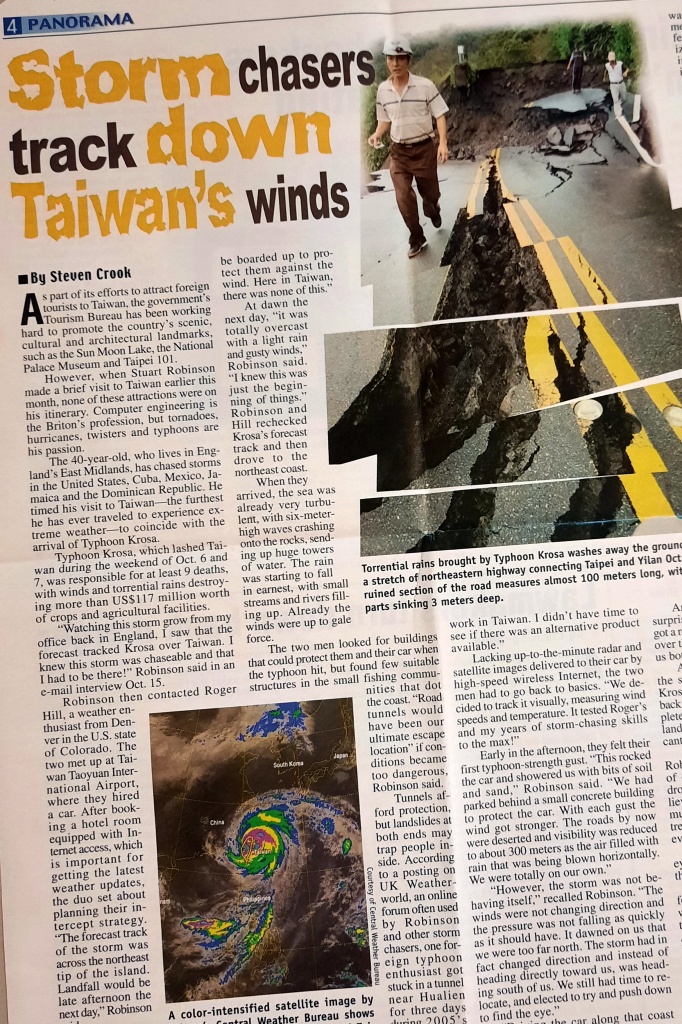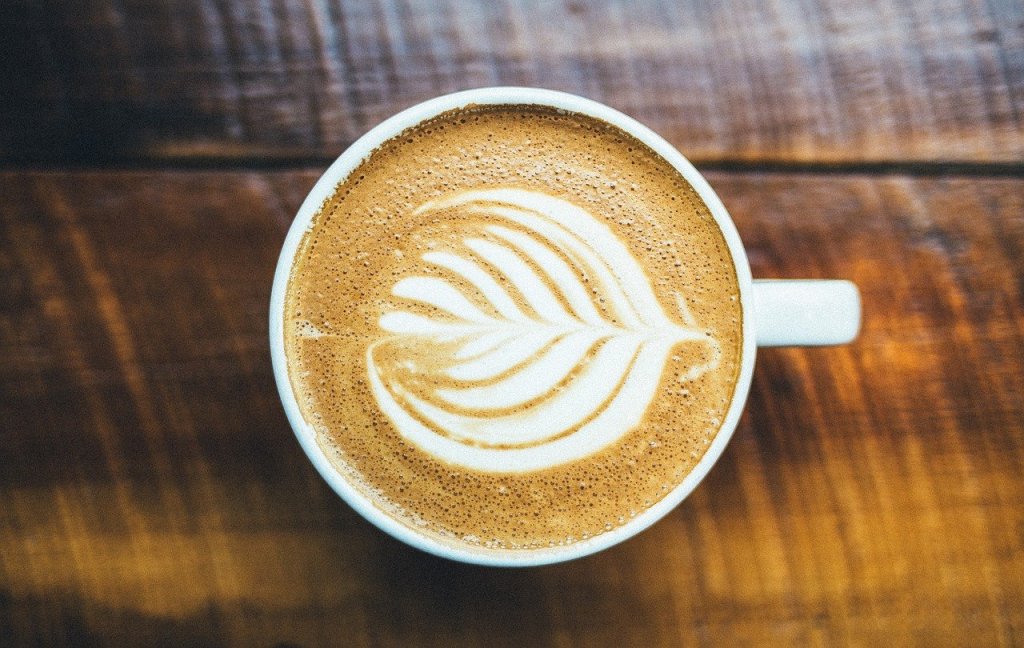This article first appeared in the October 26, 2007 issue of Taiwan Journal.
As part of its efforts to attract foreign tourists to Taiwan, the Tourism Bureau has been working hard to promote the country’s scenic, cultural and architectural landmarks, such as the Sun Moon Lake, the National Palace Museum and Taipei 101.
However, when Stuart Robinson made a brief visit to Taiwan earlier this month, none of these attractions were on his itinerary. Computer engineering is the Briton’s profession, but tornadoes, hurricanes, twisters and typhoons are his passion.
The 40-year-old, who lives in England’s East Midlands, has chased storms in the United States, Cuba, Mexico, Jamaica and the Dominican Republic. He timed his visit to Taiwan — the furthest he has ever traveled to experience extreme weather — to coincide with the arrival of Typhoon Krosa.
Typhoon Krosa, which lashed Taiwan during the weekend of October 6-7, was responsible for at least nine deaths, with winds and torrential rains destroying more than US$117 million worth of crops and agricultural facilities.
“Watching this storm grow from my office back in England, I saw that the forecast tracked Krosa over Taiwan. I knew this storm was chaseable and that I had to be there!” Robinson said in an e-mail interview October 15.
Robinson then contacted Roger Hill, a weather enthusiast from Denver in the US state of Colorado. The two met up at Taiwan Taoyuan International Airport, where they hired a car. After booking a hotel room equipped with Internet access, which is important for getting the latest weather updates, the duo set about planning their intercept strategy. “The forecast track of the storm was across the northeast tip of the island. Landfall would be late afternoon the next day,” Robinson said.
For the British storm chaser, Taiwan’s seeming lack of preparation as Krosa closed in was astounding. With the typhoon due to slam into the island in less than 24 hours, “people were carrying on with normal life,” he said. “In the Gulf of Mexico, there would be a mass evacuation, and premises would be boarded up to protect them against the wind. Here in Taiwan, there was none of this.”
At dawn the next day, “it was totally overcast with a light rain and gusty winds,” Robinson said. “I knew this was just the beginning of things.” Robinson and Hill rechecked Krosa’s forecast track and then drove to the northeast coast.
When they arrived, the sea was already very turbulent, with six-meter-high waves crashing onto the rocks, sending up huge towers of water. The rain was starting to fall in earnest, with small streams and rivers filling up. Already the winds were up to gale force.
The two men looked for buildings that could protect them and their car when the typhoon hit, but found few suitable structures in the small fishing communities that dot the coast. “Road tunnels would have been our ultimate escape location” if conditions became too dangerous, Robinson said.
Tunnels afford protection, but landslides at both ends may trap people inside. According to a posting on an online forum often used by Robinson and other storm chasers, one foreign typhoon enthusiast got stuck in a tunnel near Hualien for three days during 2005’s Typhoon Haitang.
Robinson had another problem to deal with: The satellite tracking equipment he uses to chase storms in North America does not work in Taiwan. “The footprint for the satellite covers the United States only, so I knew it wouldn’t work in Taiwan. I didn’t have time to see if there was an alternative product available.”
Lacking up-to-the-minute radar and satellite images delivered to their car by high-speed wireless Internet, the two men had to go back to basics. “We decided to track it visually, measuring wind speeds and temperature. It tested Roger’s and my years of storm-chasing skills to the max!”
Early in the afternoon, they felt their first typhoon-strength gust. “This rocked the car and showered us with bits of soil and sand,” Robinson said. “We had parked behind a small concrete building to protect the car. With each gust the wind got stronger. The roads by now were deserted and visibility was reduced to about 300 meters as the air filled with rain that was being blown horizontally. We were totally on our own.”
“However, the storm was not behaving itself,” recalled Robinson. “The winds were not changing direction and the pressure was not falling as quickly as it should have. It dawned on us that we were too far north. The storm had in fact changed direction and instead of heading directly toward us, was heading south of us. We still had time to relocate, and elected to try and push down to find the eye.”
“Driving the car along that coast road at the height of the typhoon were some of the most nerve-racking weather moments I’ve ever had,” Robinson said. “Conditions were dreadful. Even with the wipers on full I could only just keep the windscreen free of rain. The wind would rock the car and forward speed was only about 30 kilometers per hour. After a few kilometers we realized that we weren’t going to be able to make it into the eye. I pulled the car up behind a dirt embankment, and we got ready for what would be a harrowing few hours.”
“At this point we were dejected,” Robinson said. “To come all this way and miss the eye by just a few miles was very hard to take. We were soaked though, cold and hungry. Moreover, we would have to suffer the very worst and most intense winds that surrounded the eye. Getting into the eye would have at least given us a chance to escape the winds.”
Then Krosa surprised the two storm chasers again. “The winds decreased instead of increasing, and we noticed that the pressure was not falling as normal, but was increasing,” Robinson said. “We both thought that we’d missed the eye completely and it was moving away from us over land. We sat there for two hours until it was safe to drive again. It was getting dark so we decided to return to Taipei.”
Arriving in Taipei, the men were surprised to find businesses open. “We got a room and started to look at the storm over the Internet. What we saw shocked us both,” Robinson recalled.
After approaching the spot where the storm chasers had been waiting, Krosa had suddenly turned south and back out to the sea. In the end it did a complete loop over the ocean before making landfall, by which time it was significantly weaker.
“Taiwan dodged a bullet” is how Robinson described this fortuitous turn of events. “At dawn the next day we drove back out to the coast. We were relieved to see that the small fishing communities were largely unscathed. Many trees were down but there wasn’t much evidence of building damage.”
“I feel dejected that I missed the eye,” concluded Robinson. “But that’s the weather!”
Robinson and Hill were not the only foreign storm chasers who rushed to Taiwan to catch Typhoon Krosa. According to Robinson, one came from Australia. Another, a Briton working in China, flew in from Shanghai.
The latter uses the pseudonym “Typhoon Hunter,” and posted several comments and photos on the UK Weatherworld forum. “Taiwanese infrastructure held up brilliantly as usual,” he wrote, noting also that he saw no gas stations closing or running dry, no panic buying and no looting. “This was my fifth typhoon in Taiwan, and this place is definitely my favorite place to intercept.”








 So what common denominators are shared by the most popular articles? It’s very hard to say. People searching for cycling travelogs might stumble across “A modest achievement.” But of the next five? A couple are about museums (and very different museums: one focuses on
So what common denominators are shared by the most popular articles? It’s very hard to say. People searching for cycling travelogs might stumble across “A modest achievement.” But of the next five? A couple are about museums (and very different museums: one focuses on  When my first book came out, back at the start of this millennium, I was fortunate to receive a
When my first book came out, back at the start of this millennium, I was fortunate to receive a